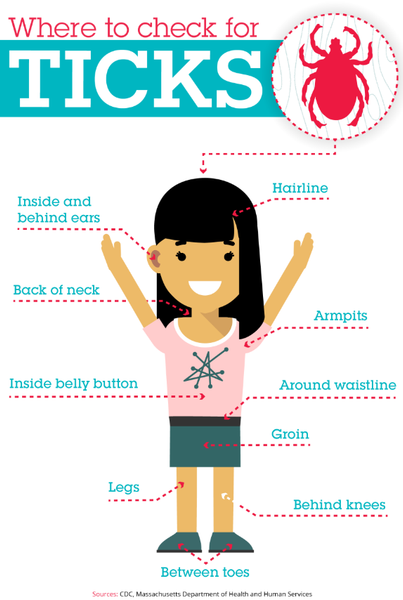Tick protection 101: 8 ways to keep your kids safe this season

Source: Web MD
Most of us are disgusted by the idea of ticks. And if you’re a parent, the thought of these tiny arachnids embedding themselves into our children’s skin is 10 times worse.
Unfortunately, kids are at real risk. The CDC reports that kids 5 to 9 years of age are most at risk of Lyme disease. Overall, some 75,000 youth are diagnosed with the illness each year, and that doesn’t account for other tick-borne illnesses or the cases of Lyme that go undiagnosed.
Naturally, no one wants to rob their children of the joy of playing outdoors during the warm, wonderful days of spring and summer. That’s why experts recommend parents take steps to protect kids from ticks so they can enjoy the outdoors. A few tips for staying proactive:
-
Start using prevention methods early. Ticks are out and about as soon as temperatures exceed 40 degrees. Be on the lookout for both adult ticks and the tiny, immature ticks that hatch each April. These immature nymphal ticks are so hard to see that they often feed unnoticed, making them more likely than adult ticks to transmit tick-borne infections to humans.
-
Reduce your tick population using Thermacell Tick Tubes. Place Thermacell Tick Control Tubes around the perimeter of your yard. Developed by Harvard University researchers, these small biodegradable tubes work with nature to help rid your yard of ticks that may carry Lyme and other diseases. How do they work? Field mice that commonly host young ticks collect the treated cotton inside the tick control tubes and use it to line their nests. The mice rub the treated cotton into their fur, killing the ticks that feed on them. Each tube can kill hundreds of ticks in a season. And you can sleep at night knowing the tubes won’t harm kids, pets, or the environment.
-
Dress kids to cover exposed skin. Reduce exposed skin by choosing long-sleeve shirts, tucking them into pants, then tucking the pants into socks or boots. Make surface ticks more visible by opting for light-colored clothing and short, braided or pulled-back hair. The CDC also recommends treating gear and clothing with sprays or lotions containing 0.5 percent permethrin. "Ticks do not jump, fly or drop from trees — they are down on the ground and crawl up until they find a good spot to attach," explains TickEncounter.org. "Tucking pant legs into socks is a good way to keep ticks on the outside where they may be seen or get brushed off."
-
Treat your pets. Treating your pets is critical, since it's easy for them to pick up ticks from the yard, neighborhood or woods and bring them into your home. Ask your veterinarian which anti-tick products she recommends for your dogs and cats.
-
Scan skin frequently. Use a magnifying glass each night to check all family members (including pets) for ticks. Ticks are attracted to warm, moist areas such as the armpits, back of knees, back of ears, scalp and groin. "The simplest way to protect yourself is to remove a tick before it has a chance to transmit disease-causing pathogens," emphasizes the TickEncounter site. "Ticks can attach anywhere ... and once attached, ticks do not wash off in the shower."
-
Reduce tick hiding place. Deer ticks prefer moist, shady areas and avoid heat and sunlight. A sunny lawn makes for poor tick habitat, while shady brush and woods can harbor them. While many families like to position pools, trampolines and kids’ playground equipment in corners away from lawn mowers, it's best to place them in the middle of your lawn in direct sunlight, at least 10 feet away from foliage and leaf litter. If you have a basketball hoop, you might also want to install barriers to prevent balls from bouncing into tick-infested foliage.
-
Landscape kids’ play areas defensively.Evaluate the green space surrounding your home and yard, then cut back or remove tall grasses, branches, brush and leaf litter that attract ticks — especially if the foliage is in shady, moist areas. Keep your lawn mowed to less than 4.5 inches tall throughout the spring and summer. Experts also recommend installing a a 3-foot gravel or wood chip barrier between the any wooded areas and your lawn. Finally, if your area is frequented by wildlife such as deer, a fence can keep them from introducing more ticks to your yard.
- Call a professional. For yards overrun with ticks, call a pest professional. He can tailor a solution for your property that may include cleaning up your yard, treating your pets, spraying your property and applying Thermacell Tick Control Tubes.
